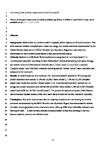Are energy and protein requirements met in hospital?
| dc.contributor.author | Pullen, K | |
| dc.contributor.author | Collins, R | |
| dc.contributor.author | Stone, T | |
| dc.contributor.author | Carter, H | |
| dc.contributor.author | Sadler, H | |
| dc.contributor.author | Collinson, Avril | |
| dc.date.accessioned | 2017-07-14T15:12:01Z | |
| dc.date.available | 2017-07-14T15:12:01Z | |
| dc.date.issued | 2017-06-06 | |
| dc.identifier.issn | 0952-3871 | |
| dc.identifier.issn | 1365-277X | |
| dc.identifier.uri | http://hdl.handle.net/10026.1/9621 | |
| dc.description | Publisher policy: author can archive post-print on institutional repository after a 12 months embargo. Publisher's version/PDF cannot be used. Publisher source must be acknowledged with citation. Must link to publisher version. | |
| dc.description.abstract |
<jats:title>Abstract</jats:title><jats:sec><jats:title>Background</jats:title><jats:p>Malnutrition is a problem within hospitals, which impacts upon clinical outcomes. The present audit assesses whether a hospital menu meets the energy and protein standards recommended by the British Dietetic Association's (BDA) <jats:italic>Nutrition and Hydration Digest</jats:italic> and determines the contribution of oral nutrition supplements (ONS) and additional snacks.</jats:p></jats:sec><jats:sec><jats:title>Methods</jats:title><jats:p>Patients in a UK South West hospital were categorised as ‘nutritionally well’ or ‘nutritionally vulnerable’ in accordance with their Malnutrition Universal Screening Tool score. Energy and protein content of food selected from the menu (‘menu choice’), menu food consumed (‘hospital intake’) and total food consumed including snacks (‘overall intake’) were calculated and compared with the standards.</jats:p></jats:sec><jats:sec><jats:title>Results</jats:title><jats:p>In total<jats:bold>,</jats:bold> 93 patients were included. For ‘nutritionally well’ patients (<jats:italic>n</jats:italic> = 81), energy and protein standards were met by 11.1% and 33.3% (‘menu choice’); 7.4% and 22.2% (‘hospital intake’); and 14.8% and 28.4% (‘overall intake’). For ‘nutritionally vulnerable’ patients (<jats:italic>n</jats:italic> = 12), energy and protein standards were met by 0% and 8.3% (‘menu choice’); 0% and 8.3% (‘hospital intake’); and 8.3% and 16.7% (‘overall intake’). Ten percent of patients consumed ONS. Patients who consumed hospital snacks (34%) were more likely to meet the nutrient standards (<jats:italic>P</jats:italic> ≤ 0.001).</jats:p></jats:sec><jats:sec><jats:title>Conclusions</jats:title><jats:p>The present audit demonstrated that most patients are not meeting the nutrient standards recommended by the BDA <jats:italic>Nutrition and Hydration Digest</jats:italic>. Recommendations include the provision of energy/protein‐dense snacks, as well as menu, offering ONS where clinically indicated, in addition to training for staff. A food services dietitian is ideally placed to lead this, forming a vital link between patients, caterers and clinical teams.</jats:p></jats:sec> | |
| dc.format.extent | 178-187 | |
| dc.format.medium | Print-Electronic | |
| dc.language | en | |
| dc.language.iso | en | |
| dc.publisher | Wiley | |
| dc.subject | energy | |
| dc.subject | hospital | |
| dc.subject | malnutrition | |
| dc.subject | nutrition | |
| dc.subject | protein | |
| dc.title | Are energy and protein requirements met in hospital? | |
| dc.type | journal-article | |
| dc.type | Journal Article | |
| plymouth.author-url | https://www.webofscience.com/api/gateway?GWVersion=2&SrcApp=PARTNER_APP&SrcAuth=LinksAMR&KeyUT=WOS:000427581700003&DestLinkType=FullRecord&DestApp=ALL_WOS&UsrCustomerID=11bb513d99f797142bcfeffcc58ea008 | |
| plymouth.issue | 2 | |
| plymouth.volume | 31 | |
| plymouth.publication-status | Published online | |
| plymouth.journal | Journal of Human Nutrition and Dietetics | |
| dc.identifier.doi | 10.1111/jhn.12485 | |
| plymouth.organisational-group | /Plymouth | |
| plymouth.organisational-group | /Plymouth/Faculty of Health | |
| plymouth.organisational-group | /Plymouth/Faculty of Health/School of Health Professions | |
| plymouth.organisational-group | /Plymouth/REF 2021 Researchers by UoA | |
| plymouth.organisational-group | /Plymouth/REF 2021 Researchers by UoA/UoA03 Allied Health Professions, Dentistry, Nursing and Pharmacy | |
| plymouth.organisational-group | /Plymouth/Research Groups | |
| plymouth.organisational-group | /Plymouth/Research Groups/Institute of Health and Community | |
| plymouth.organisational-group | /Plymouth/Research Groups/Plymouth Institute of Health and Care Research (PIHR) | |
| plymouth.organisational-group | /Plymouth/Users by role | |
| plymouth.organisational-group | /Plymouth/Users by role/Academics | |
| dc.publisher.place | England | |
| dcterms.dateAccepted | 2017-04-18 | |
| dc.rights.embargodate | 2018-6-6 | |
| dc.identifier.eissn | 1365-277X | |
| dc.rights.embargoperiod | 12 months | |
| rioxxterms.versionofrecord | 10.1111/jhn.12485 | |
| rioxxterms.licenseref.uri | http://www.rioxx.net/licenses/under-embargo-all-rights-reserved | |
| rioxxterms.licenseref.startdate | 2017-06-06 | |
| rioxxterms.type | Journal Article/Review |


